A Different Perspective of Saqsayhuaman

Abstracted through a cubist lens, a landscape of irregular shaped blocks stacked one on another in perfect fit, rises up in Inca Peru. Stone fills Cuzco, but it is not alone. It surrounds native rock, sometimes carved, sometimes not, and the combination folds into land, vegetation, and sky.
Just as stones come together to make larger shapes, and shapes with hills, mountains, trees and flowers to make landscape, so too motifs come together in potentially distinctive ways to make something intelligible, yet new.
One example of this is Saqsayhuaman, the massive monument above Cuzco.
From one view it slumps on the hills above Cuzco, from another it rises like a multi storied complex, far beyond the height of people and the nearby landscape to express the geometry of pampa, mountains, and peaks around it.
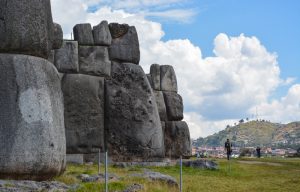
Of course, context is everything. Many people may think of Saqsayhuaman, whose name simply means “resting falcon” as being what lies between the massive, zigzagged wall–where most of the tour guides focus their explanatory efforts–and the edge which drops down to the city.

As an aside, it is worth noting how the zig-zagged complex has been made into a text by tour guides, who like students working a book in a foreign script find partial and broken meanings in it that mobilize what they think the Incas were and what “Andean” civilization was like. They are creating texts of commentary and interpretation which are fascinating in themselves, but not the topic of this post.
Prior to the deliberate forgetting and studied covering of Inca monuments following the Spanish invasion, it seems tiers of terraces rose from the city and connected it to Saqsayhuaman as one of a trinity of major sacred places: the Qoricancha (enclosure of the sun), the divided plaza of the town that became the Plaza de Armas and Plaza de Regocijo of colonial Cuzco, as well as Saqsayhuaman. It was not separate, but drawn in to a layered and differentiated landscape to which it related; it drew, and gave meaning.
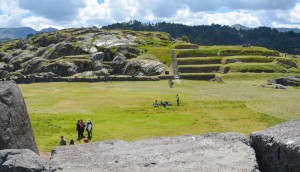
Together, the three areas– the zigzag, the plaza, and the rising rock with fine stone work– make a complex that itself is a motif that is found elsewhere.
I do not know what archeologists have find in any excavations they have done on these sites, especially on the esplanade. The current appearance of Saqsayhuaman could very easily be misleading. In fact as more and more of the area is cleared and “restored” the site becomes every more complex and changes.
Nevertheless, it is worth noticing the similarity of what we see today with elsewhere, since, as anthropologist Catherine Allen notes in her book Fox Boy, the repetition and of motifs and twining them into new fabrics (landscapes) is important in contemporary and probably pre-Columbian aesthetics.
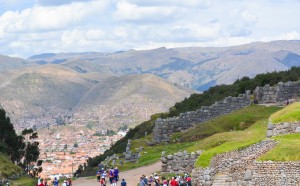
Where else do we see something reminiscent of the three part form of contemporary Saqsayhuaman?
Machu Picchu seems like a smaller-scaled model of the same, with its temple complex, plaza, and residential areas. They are surprisingly like those that are much more massively represented in Saqsayhuaman.
Intriguingly, the three part model of major shrines in Cuzco also reminds me of Saqsayhuaman. It two has a complex of buildings on one side (with the Qori Cancha as its main orientation), a pampa–a flat area or ground, and another area of buildings.
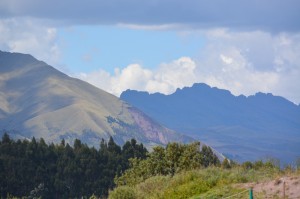
Saqsayhuaman, even as three (whether with the temple of the sun and the main squares or in its internal composition) is part of an entire precinct of shrines and temples, most of which are invisible to the casual visitor. Together, they make an enormous ritual precinct that covers kilometers of landscape.
Cuzco needs a museum of Inca Cuzco to do for it what the Casa Concha is increasingly doing for Machu Picchu. I am not referring to all the material found in various excavations, formal and casual, but to the interpretation that the videos and models make of the World Heritage site on a saddle: Machu Picchu.
Cuzco needs to be made visible for visitors and locals alike and it needs to be interpreted by professional archeologists, art historians, architects, and ethnohistorians.
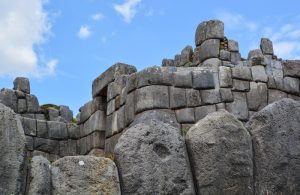
One difference between a museum of Cuzco and the Casa Concha: A display of Inca Cuzco should also relate to the current city, such as to the people who make offerings to the Apu of Sacsayhuaman today, or the tour guides with their growing corpus of interpretations.
Cuzco is a living, vital city and not simply an archeological site. Saqsayhuaman lives too. People of many different kinds fill it and perform many different activities there. They engage it in many different ways.
It still is a shrine, enormous, irregular blocks that fit together, as if a landscape where people come and find meaning.




